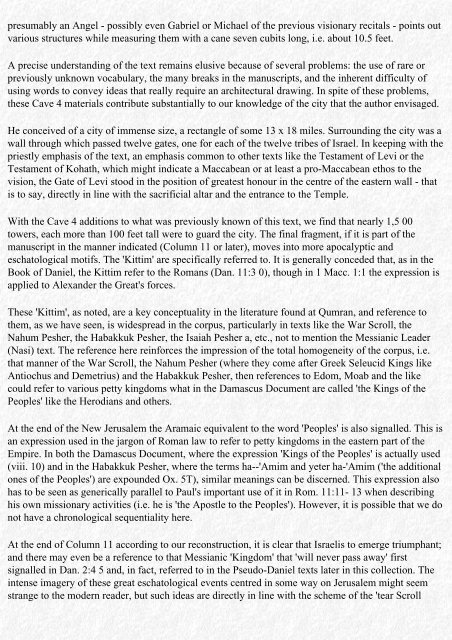Dead Sea Scrolls Uncovered - The Preterist Archive
Dead Sea Scrolls Uncovered - The Preterist Archive
Dead Sea Scrolls Uncovered - The Preterist Archive
You also want an ePaper? Increase the reach of your titles
YUMPU automatically turns print PDFs into web optimized ePapers that Google loves.
presumably an Angel - possibly even Gabriel or Michael of the previous visionary recitals - points out<br />
various structures while measuring them with a cane seven cubits long, i.e. about 10.5 feet.<br />
A precise understanding of the text remains elusive because of several problems: the use of rare or<br />
previously unknown vocabulary, the many breaks in the manuscripts, and the inherent difficulty of<br />
using words to convey ideas that really require an architectural drawing. In spite of these problems,<br />
these Cave 4 materials contribute substantially to our knowledge of the city that the author envisaged.<br />
He conceived of a city of immense size, a rectangle of some 13 x 18 miles. Surrounding the city was a<br />
wall through which passed twelve gates, one for each of the twelve tribes of Israel. In keeping with the<br />
priestly emphasis of the text, an emphasis common to other texts like the Testament of Levi or the<br />
Testament of Kohath, which might indicate a Maccabean or at least a pro-Maccabean ethos to the<br />
vision, the Gate of Levi stood in the position of greatest honour in the centre of the eastern wall - that<br />
is to say, directly in line with the sacrificial altar and the entrance to the Temple.<br />
With the Cave 4 additions to what was previously known of this text, we find that nearly 1,5 00<br />
towers, each more than 100 feet tall were to guard the city. <strong>The</strong> final fragment, if it is part of the<br />
manuscript in the manner indicated (Column 11 or later), moves into more apocalyptic and<br />
eschatological motifs. <strong>The</strong> 'Kittim' are specifically referred to. It is generally conceded that, as in the<br />
Book of Daniel, the Kittim refer to the Romans (Dan. 11:3 0), though in 1 Macc. 1:1 the expression is<br />
applied to Alexander the Great's forces.<br />
<strong>The</strong>se 'Kittim', as noted, are a key conceptuality in the literature found at Qumran, and reference to<br />
them, as we have seen, is widespread in the corpus, particularly in texts like the War Scroll, the<br />
Nahum Pesher, the Habakkuk Pesher, the Isaiah Pesher a, etc., not to mention the Messianic Leader<br />
(Nasi) text. <strong>The</strong> reference here reinforces the impression of the total homogeneity of the corpus, i.e.<br />
that manner of the War Scroll, the Nahum Pesher (where they come after Greek Seleucid Kings like<br />
Antiochus and Demetrius) and the Habakkuk Pesher, then references to Edom, Moab and the like<br />
could refer to various petty kingdoms what in the Damascus Document are called 'the Kings of the<br />
Peoples' like the Herodians and others.<br />
At the end of the New Jerusalem the Aramaic equivalent to the word 'Peoples' is also signalled. This is<br />
an expression used in the jargon of Roman law to refer to petty kingdoms in the eastern part of the<br />
Empire. In both the Damascus Document, where the expression 'Kings of the Peoples' is actually used<br />
(viii. 10) and in the Habakkuk Pesher, where the terms ha--'Amim and yeter ha-'Amim ('the additional<br />
ones of the Peoples') are expounded Ox. 5T), similar meanings can be discerned. This expression also<br />
has to be seen as generically parallel to Paul's important use of it in Rom. 11:11- 13 when describing<br />
his own missionary activities (i.e. he is 'the Apostle to the Peoples'). However, it is possible that we do<br />
not have a chronological sequentiality here.<br />
At the end of Column 11 according to our reconstruction, it is clear that Israelis to emerge triumphant;<br />
and there may even be a reference to that Messianic 'Kingdom' that 'will never pass away' first<br />
signalled in Dan. 2:4 5 and, in fact, referred to in the Pseudo-Daniel texts later in this collection. <strong>The</strong><br />
intense imagery of these great eschatological events centred in some way on Jerusalem might seem<br />
strange to the modern reader, but such ideas are directly in line with the scheme of the 'tear Scroll

















